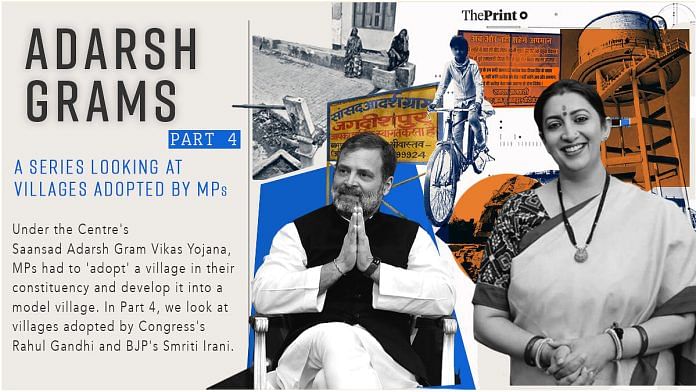New Delhi: Separated by 44 km, Jagdishpur and Sujanpur villages are bracketed together each time a discussion on ‘development’ takes place among locals and outsiders. The comparison seemingly comes up as they were adopted by rival MPs Rahul Gandhi and Smriti Irani under the Saansad Adarsh Gram Yojana (SAGY).
In Jagdishpur, local residents cannot forget the initial ecstasy after they learnt that the Congress MP had adopted their village in 2014. That year, Rahul had defeated Irani in Amethi parliamentary seat by a margin of 1.07 lakh votes.
“Several people were happy with the announcement. It was like Holi across the village. Then we also had a programme by Rahul Gandhi ji in the nearby Ram Leela maidan,” Bal Govind Mishra, a Jagdishpur resident, tells ThePrint.
Jagdishpur falls in Uttar Pradesh’s Raebareli district, but is a part of the Amethi parliamentary constituency.
“When we found out that our sansadji (MP) had adopted our village, it was like Ram returning to Ayodhya… We thought our village would transform, and we’d start living in heaven,” Manish Kumar Tiwari, another resident, recalled.
The bubble burst soon when Rahul reached Jagdishpur — so much so that the villagers burnt his effigy right at the Ram Leela ground where he addressed the crowd questioning the model village scheme.
“From that stage itself, he (Rahul) announced, ‘I’ve adopted the village, but where will the money to develop the village actually come from’. The people got really disappointed then… And since then, no development work has happened in the village from his side,” Mishra says.
The villagers, he says, then burnt Rahul’s effigy in protest, after he left the programme.
In contrast, there are boards in Sujanpur put up with the support of the current pradhan, saying, ‘Didi Smriti Irani has changed the face of the village by adopting it…we won’t vote for the Congress’.
Adopted by Union Minister Smriti Irani in 2019, the village has seen Corporate Social Responsibility (CSR) funds arrive since it was adopted by the Amethi MP.
Yet, discrepancies do exist. For instance, there were barely any roads in the interiors of the village. ThePrint also came across three women on their way to the fields to defecate. “We don’t have a washroom. We go to the fields in the afternoon,” one of the women said.
Also Read: ‘Izzat ghars’ to ATMs, Modi’s adopted villages have leaped into 21st-century India, with some bumps
‘He who considers you family’
The events leading up to the burning of Rahul’s effigy are still imprinted on the minds of the residents of Jagdishpur village.
“We felt like we were shown a dream and then deceived,” Tiwari tells ThePrint.
The episode seems to have left a strong impression on the minds of the residents.
Another Jagdishpur local Batan Devi Shukla tells ThePrint that the adoption had led the people to believe that the village would finally get covered drains, roads. “But when he (Rahul) asked where the money would come from, we stopped expecting anything from him. Never voted for him again, too…Otherwise, we used to always make him win.”
When the results came out in 2019, Rahul lost to BJP’s Smriti Irani by a margin of 55,000-plus votes.
Last week, Irani addressed Jagdishpur at the same Ram Leela ground which hosted Rahul in 2014. “Rahul Gandhi adopted our village and disappeared in thin air,” a village resident hollered from the crowd during her speech.
“One adopts who considers you as family. He (Rahul) has gone and called Wayanad his family,” Irani responded from the stage.
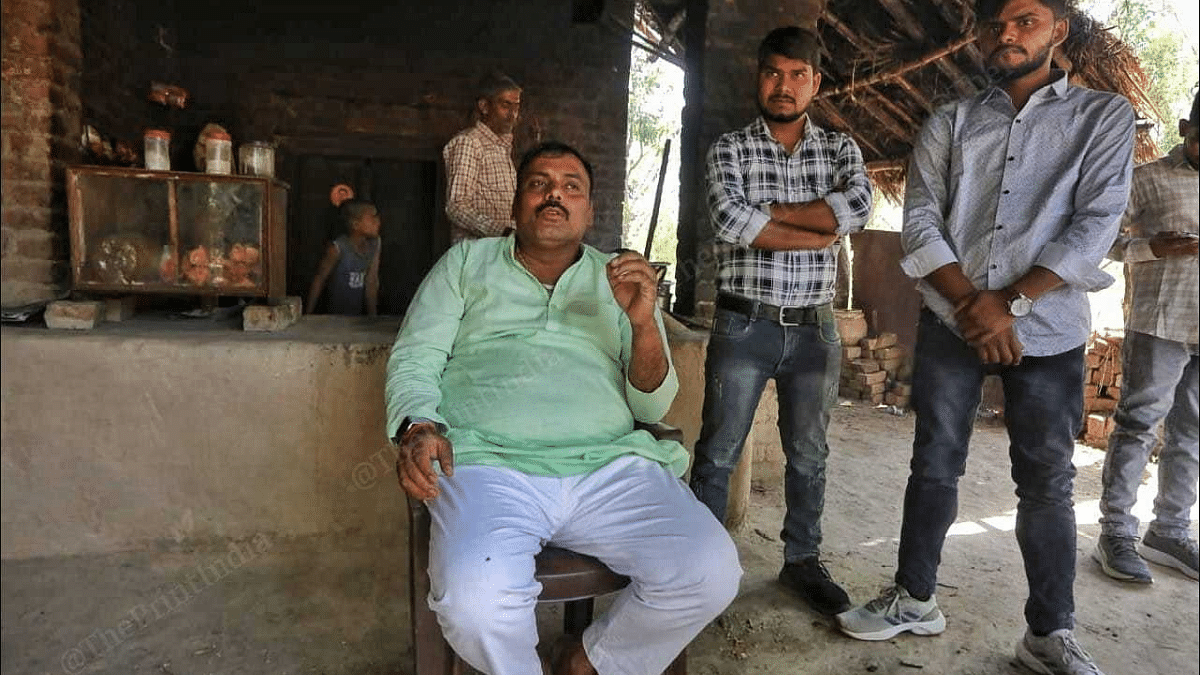
Jagdishpur gram panchayat pradhan Vimal Kumar Srivastava recalls that after Rahul adopted the village, the roads and drains of the village were measured for development work. “There was no street left that wasn’t measured.”
A baseline survey of the village was also conducted, and uploaded on the SAGY website.
“But later, he did not do anything…He (Rahul) told us that he’ll work for us under this scheme if he gets separate funding. Else, he will work for his entire parliamentary area,” Srivastava says.
“Why did he adopt the village when he did not know where the funds would come from…If he had raised it in Parliament, we would’ve understood, but he stood amongst us and said that,” Tiwari chips in.
One of the biggest criticisms of the SAGY has been the lack of separate funding for its implementation. The SAGY website makes it clear that “no additional funding is deemed necessary” for the scheme.
The SAGY, however, converges resources from a range of resources available including existing central sector, centrally sponsored and state schemes to achieve its objectives. Therefore, among other resources, money from the Backward Region Grant Fund (BRGF) and the Members of Parliament Local Area Development Scheme (MPLADS), can be used to this end.
Who brought vikas?
In the past 10 years, Jagdishpur with 4,000 voters has had several of its roads fixed. Government officials tell ThePrint that since 2016, 320 ‘awas’ (houses) have been built under the Pradhan Mantri Awas Yojana-Gramin, and so were 980 individual toilets.
However, several residents like Kalawati and Seema Devi still struggle for basic necessities like clean water. “The hand pump doesn’t give good water…If you fill it and store it, the water turns yellow…So, we can only use it for bathing or washing clothes,” Kalawati tells ThePrint, as she points at the hand pump outside their house.
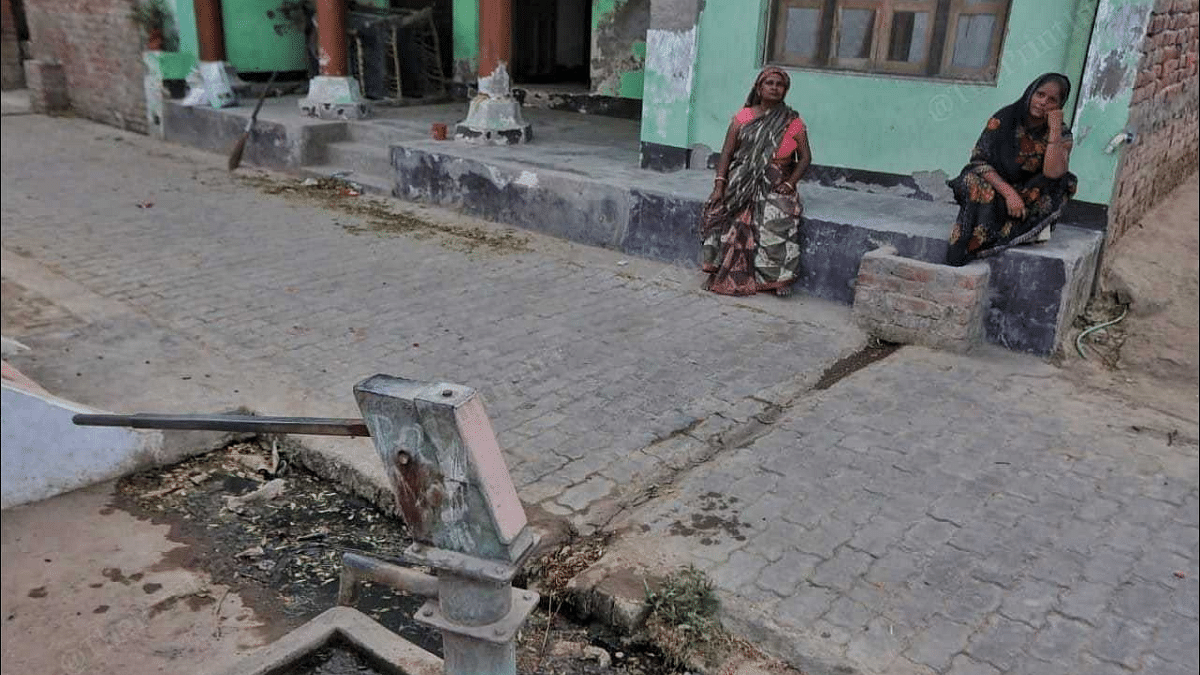
Several residents say they have to buy water for drinking, because they don’t have a tap connection.
While a few households claim that the water tank was built under Rahul’s watch, no one could ascertain it. In any case, the tank hasn’t been supplying water for a few months now. The village doesn’t have a hospital, and has a health centre instead. It doesn’t have bank branches or ATM and has several open drains with mosquitoes buzzing above.
Any ‘vikas’ (development) that has happened since in Jagdishpur, the people either credited the Uttar Pradesh government for it or the local gram panchayat. The village has a school, interlocking road connectivity, and a few solar street lights.
“In these 10 years, work has been done in the village. There has been change. Several roads inside the village have become better, there are interlocking roads…We have constant electricity too,” Mishra says.
He credits the Yogi Adityanath-led UP government that took charge in 2017 for bringing in this change.
Another resident Karunesh Kumar Singh credits the gram panchayat for the development. “We used to have water-filled roads. Even when Rahul Gandhi ji came, the roads were then water-logged,” he tells ThePrint.
Also Read: Broken sewage system, filthy ponds—Keorak, village adopted by ex-CM Khattar, ‘worse off than before’
Roads, water tank, amrit sarovar
On the other hand, Sujanpur, which has about 3,200 voters, has received Corporate Social Responsibility (CSR) funds, since it was adopted by Irani.
About Rs 9.2 crore funding came from Hindustan Aeronautics Limited (HAL), Korwa, for building of interlocking and cement concrete roads and a few drains — several boards put up in the village acknowledged this funding.
On paper, a total of 49 such road building projects were taken up since 2019, with road lengths ranking from 12 m to 466 m funded through CSR and other resources like gram panchayat funds.
In addition, a 6.7 km main road was built using funds from the Pradhan Mantri Gram Sadak Yojana (PMGSY). Out of the 6.7 km, 898 m of the road runs through Sujanpur.
Kamlesh Kumar, a resident, says that Sujanpur has witnessed construction of several roads since Irani adopted it. The situation, he says, “is much better now”, but adds that there are still several lanes without any paved road.
“Didi Smriti Irani had visited the village also, but she usually only comes till here (the main road), and leaves.”
Another Sujanpur local Raju Prajapat, too, appreciates the work done so far. “Work is being done. Roads, water tank. Electricity troubles are going away. It hasn’t happened entirely, but things are getting better…There are some people who are still left behind, but we’re hoping that things will get better for everybody.”
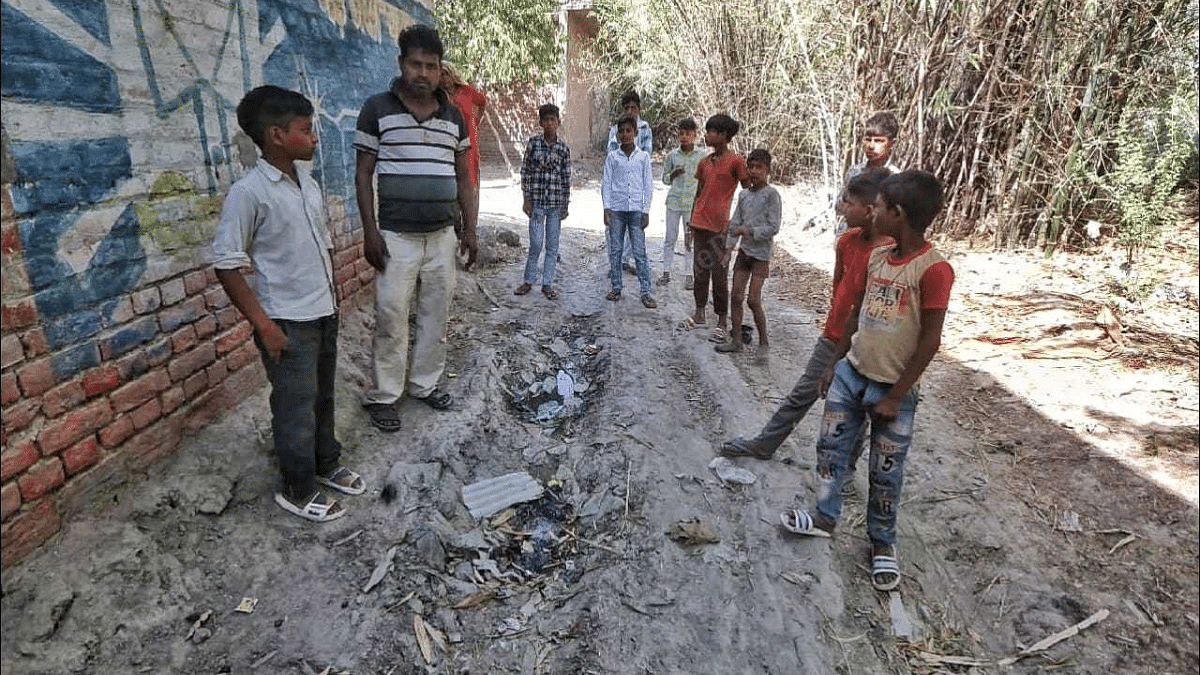
However, the lanes inside the village are barely paved. A few interlocking roads that were built during this time have also borne the brunt of rains and tractors, leading to only exposed frames left behind.
“There are no drains anywhere. They said they’ll make colonies, that hasn’t happened yet. What has she done? No washrooms, nothing at all. There are no facilities here at all,” Saheeda, a resident, tells ThePrint. “We don’t have a tap. There’s no place to sit in the house, where will the tap be?”
Saheeda’s husband works as a daily wage labourer in Dehradun, while she takes care of their three daughters and a son. “There’s nobody to listen to us…When politicians come, they return from the main road outside…The adoption is just on the papers, no work is being done.”
In another corner of Sujanpur, Munshi Raja rues the lack of roads inside the village. “The roads are all broken and have water-filled potholes. The entire area gets flooded. We can’t even get a cycle or a motorcycle through these roads,” the resident says.
‘Won’t vote for Congress’
Additionally, an Amrit Sarovar (pond) has been built in Sujanpur since. ThePrint also visited the construction site of the water tank in the village. A board outside the site said that the work had begun in October 2021.
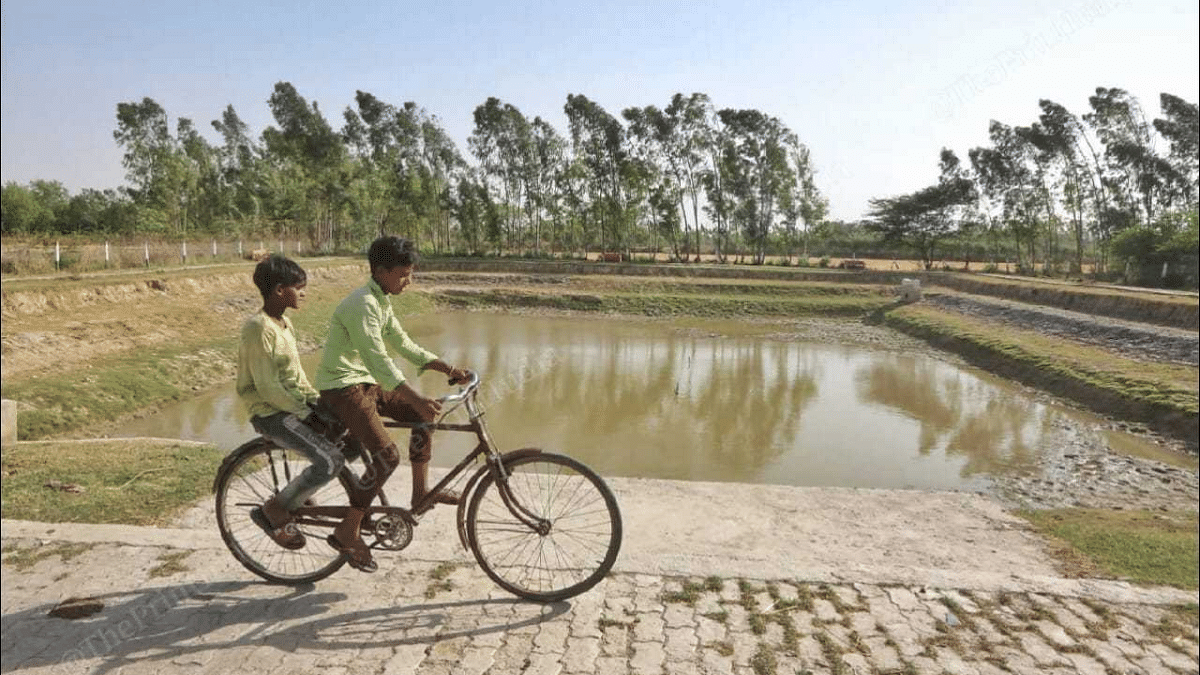
A status report of the work done under the SAGY since 2019 said that 76 percent work related to drinking water and rural pipelines was complete. But, several families don’t have a tap in their houses. Their lanes either don’t have drains, or have open drains infested with mosquitos.
Earlier this month, former Congress MLC Deepak Singh stirred up a storm when he made a statement, saying that “when she (Irani) couldn’t do anything in her adopted village, what could she have done for Amethi”.
Singh had visited the village and had put up posts on X, formerly Twitter, critical of the Union minister as well.
आज स्मृति ईरानी के गोद लिए गांव सुजानपुर से कांग्रेस के "घर घर गारंटी अभियान" के तहत गारंटी कार्ड वितरित किया।
स्मृति ईरानी जी ने इस गांव को गोद लिया है, पर यहां भी एक भी विकास का काम नहीं कर सकीं, मोदी जी के इस ड्रीम प्रोजेक्ट पर हर महीने गाँव आना था पर नहीं आईं, यहां की सड़के… pic.twitter.com/OSbbJ0PBwl
— Deepak Singh दीपक सिंह (@DeepakSinghINC) April 7, 2024
On 12 April, in another tweet, Singh wrote about how Irani couldn’t spend her MPLADS fund, and wrote, “If only she had given this money to her adopted village Sujanpur, then some work would have been done there from her MP fund.”
Singh’s statements did not sit well with certain sections of people in Sujanpur, who then put up boards in Hindi declaring that the Congress leader “insulted the village by lying”.
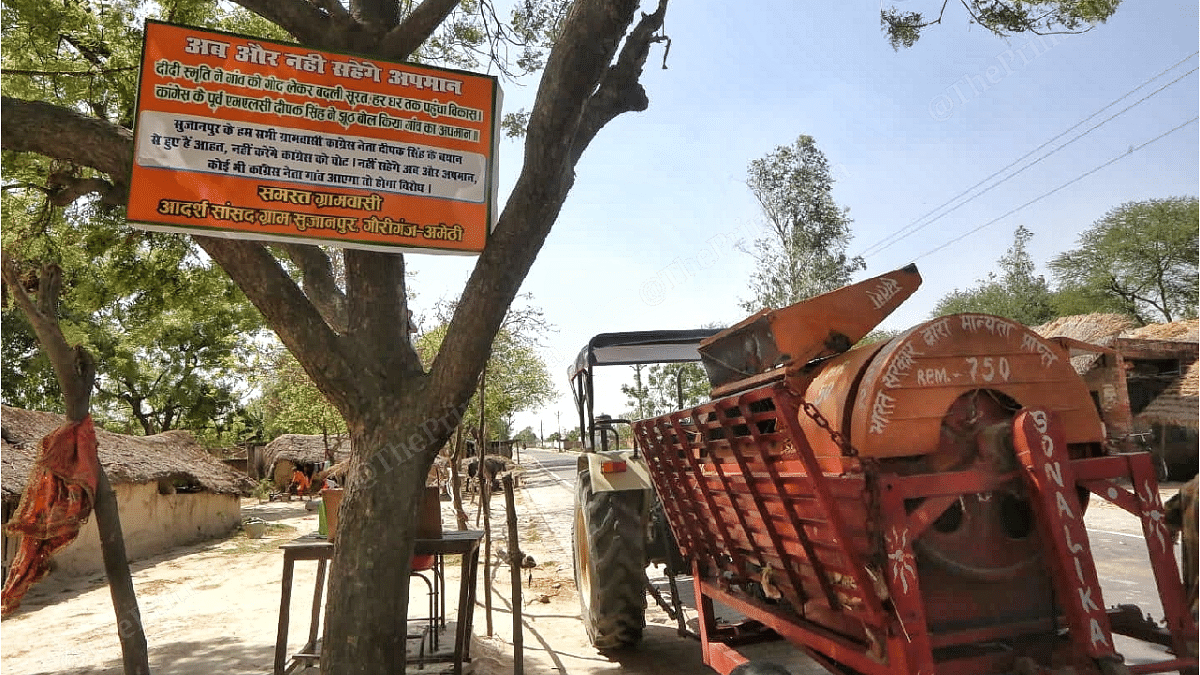
“All of Sujanpur is hurt by the statement of Congress leader Deepak Singh. We will not vote for Congress. If any Congress leader comes to the village, there will be protest,” the board says in its message.
(Edited by Tony Rai)


